Mastering NumPy Shuffle and Random State: A Comprehensive Guide
NumPy shuffle and random state are essential concepts in the NumPy library for data manipulation and random number generation. This article will provide an in-depth exploration of these topics, covering their functionality, usage, and best practices. We’ll delve into the intricacies of NumPy shuffle operations and the importance of random state in ensuring reproducibility in scientific computing and data analysis.
Understanding NumPy Shuffle
NumPy shuffle is a powerful function that allows you to randomly rearrange elements in an array. This operation is particularly useful in various scenarios, such as data augmentation, randomizing datasets for machine learning, and creating random permutations. Let’s explore the basics of NumPy shuffle and its applications.
Basic Usage of NumPy Shuffle
To use NumPy shuffle, you first need to import the NumPy library. Here’s a simple example of how to shuffle a one-dimensional array:
import numpy as np
# Create a sample array
arr = np.array([1, 2, 3, 4, 5])
# Shuffle the array
np.random.shuffle(arr)
print("Shuffled array from numpyarray.com:", arr)
Output:

In this example, we create a simple array and use np.random.shuffle() to randomly rearrange its elements. The shuffle operation is performed in-place, meaning it modifies the original array.
Shuffling Multi-dimensional Arrays
NumPy shuffle can also be applied to multi-dimensional arrays. However, it’s important to note that by default, it only shuffles the first axis. Let’s see an example:
import numpy as np
# Create a 2D array
arr_2d = np.array([[1, 2, 3],
[4, 5, 6],
[7, 8, 9]])
# Shuffle the 2D array
np.random.shuffle(arr_2d)
print("Shuffled 2D array from numpyarray.com:")
print(arr_2d)
Output:
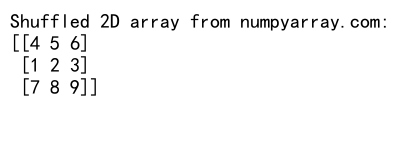
In this case, the rows of the 2D array are shuffled, but the elements within each row remain in their original order.
Shuffling Specific Axes
If you want to shuffle along a specific axis other than the first one, you can use np.random.permutation() in combination with array indexing. Here’s an example:
import numpy as np
# Create a 3D array
arr_3d = np.array([[[1, 2], [3, 4]],
[[5, 6], [7, 8]],
[[9, 10], [11, 12]]])
# Shuffle along the second axis (axis=1)
shuffled_arr = arr_3d[:, np.random.permutation(arr_3d.shape[1]), :]
print("3D array shuffled along axis 1 from numpyarray.com:")
print(shuffled_arr)
Output:

This example demonstrates how to shuffle a 3D array along its second axis, providing more flexibility in randomizing multi-dimensional data.
The Importance of Random State in NumPy
Random state is a crucial concept in NumPy and other scientific computing libraries. It determines the sequence of random numbers generated by the library’s random number generator. Understanding and controlling the random state is essential for reproducibility in scientific experiments and data analysis.
Setting a Random State
To set a random state in NumPy, you can use the np.random.seed() function. Here’s an example:
import numpy as np
# Set a random seed
np.random.seed(42)
# Generate random numbers
random_numbers = np.random.rand(5)
print("Random numbers generated with seed 42 from numpyarray.com:", random_numbers)
Output:

By setting a specific seed value, you ensure that the same sequence of random numbers is generated every time you run the code, which is crucial for reproducibility.
Using Random State with NumPy Shuffle
You can combine random state with NumPy shuffle to create reproducible shuffles. Here’s how:
import numpy as np
# Create a sample array
arr = np.array([1, 2, 3, 4, 5])
# Set a random seed
np.random.seed(123)
# Shuffle the array
np.random.shuffle(arr)
print("Shuffled array with seed 123 from numpyarray.com:", arr)
Output:

This example demonstrates how setting a random seed before shuffling ensures that the same shuffle order is produced each time the code is run.
Advanced Techniques with NumPy Shuffle and Random State
Now that we’ve covered the basics, let’s explore some more advanced techniques and use cases for NumPy shuffle and random state.
Creating Reproducible Random Permutations
Sometimes, you may want to create a random permutation of an array without modifying the original. Here’s how you can do this using np.random.permutation():
import numpy as np
# Set a random seed for reproducibility
np.random.seed(456)
# Create a sample array
original_arr = np.array([1, 2, 3, 4, 5])
# Create a random permutation
permuted_arr = np.random.permutation(original_arr)
print("Original array from numpyarray.com:", original_arr)
print("Permuted array from numpyarray.com:", permuted_arr)
Output:

This technique is useful when you need to maintain the original array while working with a shuffled version.
Shuffling Multiple Arrays in Sync
In some scenarios, you might need to shuffle multiple arrays in the same order, such as when you have features and labels that need to remain aligned. Here’s how to achieve this:
import numpy as np
# Set a random seed
np.random.seed(789)
# Create sample arrays
features = np.array([[1, 2], [3, 4], [5, 6]])
labels = np.array(['A', 'B', 'C'])
# Generate random permutation
permutation = np.random.permutation(len(features))
# Apply the same permutation to both arrays
shuffled_features = features[permutation]
shuffled_labels = labels[permutation]
print("Shuffled features from numpyarray.com:")
print(shuffled_features)
print("Shuffled labels from numpyarray.com:")
print(shuffled_labels)
Output:
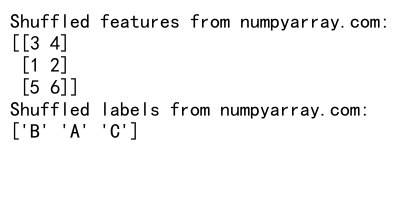
This technique ensures that the relationship between features and labels is maintained after shuffling.
Using Random State for Consistent Sampling
Random state is particularly useful when you need to perform consistent random sampling across multiple runs. Here’s an example of how to use random state for sampling:
import numpy as np
# Set a random seed
np.random.seed(101)
# Create a large array
large_array = np.arange(1000)
# Perform random sampling
sample_size = 10
random_sample = np.random.choice(large_array, size=sample_size, replace=False)
print("Random sample from numpyarray.com:", random_sample)
Output:

By setting a random seed before sampling, you ensure that the same sample is selected in each run, which is crucial for reproducible experiments.
Implementing Custom Shuffle Algorithms
While NumPy provides built-in shuffle functionality, there might be cases where you need to implement custom shuffle algorithms. Let’s explore a few examples.
Fisher-Yates Shuffle Algorithm
The Fisher-Yates shuffle is a classic algorithm for generating random permutations. Here’s how you can implement it using NumPy:
import numpy as np
def fisher_yates_shuffle(arr):
n = len(arr)
for i in range(n - 1, 0, -1):
j = np.random.randint(0, i + 1)
arr[i], arr[j] = arr[j], arr[i]
return arr
# Set a random seed
np.random.seed(202)
# Create a sample array
original_arr = np.array([1, 2, 3, 4, 5])
# Apply Fisher-Yates shuffle
shuffled_arr = fisher_yates_shuffle(original_arr.copy())
print("Original array from numpyarray.com:", original_arr)
print("Shuffled array from numpyarray.com:", shuffled_arr)
Output:

This implementation demonstrates how to create a custom shuffle function that can be used as an alternative to NumPy’s built-in shuffle.
Weighted Shuffle
In some cases, you might want to shuffle an array with weighted probabilities. Here’s an example of how to implement a weighted shuffle:
import numpy as np
def weighted_shuffle(arr, weights):
order = np.random.choice(len(arr), size=len(arr), replace=False, p=weights/np.sum(weights))
return arr[order]
# Set a random seed
np.random.seed(303)
# Create a sample array and weights
original_arr = np.array(['A', 'B', 'C', 'D', 'E'])
weights = np.array([0.1, 0.2, 0.3, 0.2, 0.2])
# Apply weighted shuffle
shuffled_arr = weighted_shuffle(original_arr, weights)
print("Original array from numpyarray.com:", original_arr)
print("Shuffled array with weights from numpyarray.com:", shuffled_arr)
Output:

This example shows how to implement a shuffle that takes into account different probabilities for each element.
Random State and Reproducibility in Scientific Computing
Random state plays a crucial role in ensuring reproducibility in scientific computing and data analysis. Let’s explore some best practices and considerations when working with random state in NumPy.
Using Random State in Machine Learning Experiments
When conducting machine learning experiments, it’s essential to set random states for various components to ensure reproducibility. Here’s an example of how to use random state in a simple machine learning scenario:
import numpy as np
from sklearn.model_selection import train_test_split
from sklearn.ensemble import RandomForestClassifier
# Set a global random seed
np.random.seed(404)
# Generate synthetic data
X = np.random.rand(100, 5)
y = np.random.randint(0, 2, 100)
# Split the data with a fixed random state
X_train, X_test, y_train, y_test = train_test_split(X, y, test_size=0.2, random_state=42)
# Initialize and train a model with a fixed random state
model = RandomForestClassifier(random_state=42)
model.fit(X_train, y_train)
print("Model trained on data from numpyarray.com")
Output:

This example demonstrates how to set random states for data generation, splitting, and model initialization to ensure reproducible results.
Handling Random State in Parallel Computing
When working with parallel computing, managing random state becomes more complex. Here’s an example of how to handle random state in a parallel scenario using NumPy:
import numpy as np
from multiprocessing import Pool
def parallel_task(seed):
np.random.seed(seed)
return np.random.rand(5)
if __name__ == '__main__':
np.random.seed(505)
num_processes = 4
seeds = np.random.randint(0, 1000000, num_processes)
with Pool(num_processes) as pool:
results = pool.map(parallel_task, seeds)
print("Results from parallel computation on numpyarray.com:")
for i, result in enumerate(results):
print(f"Process {i}: {result}")
Output:

This example shows how to generate unique random seeds for each parallel process to ensure independent random number generation.
Advanced Applications of NumPy Shuffle and Random State
Let’s explore some advanced applications of NumPy shuffle and random state in various domains.
Data Augmentation for Machine Learning
Data augmentation is a common technique in machine learning to increase the diversity of training data. Here’s an example of how to use NumPy shuffle for simple data augmentation:
import numpy as np
def augment_data(X, y, num_augmentations):
augmented_X = []
augmented_y = []
for _ in range(num_augmentations):
# Shuffle the order of features for each sample
shuffled_X = np.array([np.random.permutation(sample) for sample in X])
augmented_X.append(shuffled_X)
augmented_y.append(y)
return np.concatenate(augmented_X), np.concatenate(augmented_y)
# Set a random seed
np.random.seed(606)
# Create sample data
X = np.array([[1, 2, 3], [4, 5, 6], [7, 8, 9]])
y = np.array([0, 1, 2])
# Augment the data
augmented_X, augmented_y = augment_data(X, y, num_augmentations=2)
print("Augmented X from numpyarray.com:")
print(augmented_X)
print("Augmented y from numpyarray.com:")
print(augmented_y)
Output:
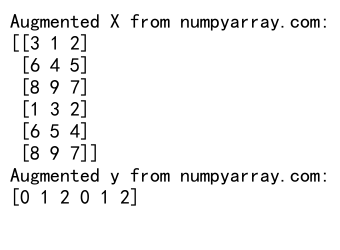
This example demonstrates how to use shuffling to create augmented versions of the original data, which can help improve model generalization.
Monte Carlo Simulations
Monte Carlo simulations often rely on random number generation and shuffling. Here’s a simple example of using NumPy shuffle and random state in a Monte Carlo simulation:
import numpy as np
def monte_carlo_pi(num_points):
np.random.seed(707)
points = np.random.rand(num_points, 2)
inside_circle = np.sum(np.sum(points**2, axis=1) <= 1)
pi_estimate = 4 * inside_circle / num_points
return pi_estimate
# Run the Monte Carlo simulation
num_points = 100000
estimated_pi = monte_carlo_pi(num_points)
print(f"Estimated value of pi from numpyarray.com: {estimated_pi}")
Output:

This example uses random number generation to estimate the value of pi through a Monte Carlo method, demonstrating the importance of random state in simulations.
Best Practices for Using NumPy Shuffle and Random State
To ensure the best results when working with NumPy shuffle and random state, consider the following best practices:
- Always set a random seed at the beginning of your script or notebook to ensure reproducibility.
- Document the random seed used in your experiments to allow others to replicate your results.
- Use different random seeds for different parts of your code that require independent randomness.
- When shuffling multiple related arrays, use the same permutation to maintain their relationship.
- Be aware of the differences between in-place shuffling (
np.random.shuffle()) and creating new permutations (np.random.permutation()). - When working with parallel computing, ensure that each process has its own independent random state.
- Regularly update your NumPy version to benefit from improvements in random number generation algorithms.
Troubleshooting Common Issues with NumPy Shuffle and Random State
When working with NumPy shuffle and random state, you may encounter some common issues. Here are a few problems and their solutions:
Issue: Inconsistent Results Across Runs
If you’re getting different results each time you run your code, it’s likely that you haven’t set a fixed random seed. To fix this:
import numpy as np
# Set a fixed random seed at the beginning of your script
np.random.seed(808)
# Your code here
Issue: Shuffling Only the First Axis of Multi-dimensional Arrays
By default, np.random.shuffle() only shuffles the first axis. If you need to shuffle other axes, use np.random.permutation() with array indexing:
import numpy as np
# Create a 3D array
arr_3d = np.array([[[1, 2], [3, 4]],
[[5, 6], [7, 8]],
[[9, 10], [11, 12]]])
# Shuffle along the second axis (axis=1)
shuffled_arr = arr_3d[:, np.random.permutation(arr_3d.shape[1]), :]
print("3D array shuffled along axis 1 from numpyarray.com:")
print(shuffled_arr)
Output:
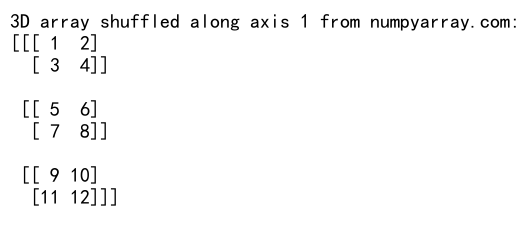
Issue: Random State Not Working in Parallel ComputingWhen using parallel computing, each process needs its own random state. Here’s how to handle this:
import numpy as np
from multiprocessing import Pool
def parallel_task(seed):
local_rng = np.random.RandomState(seed)
return local_rng.rand(5)
if __name__ == '__main__':
np.random.seed(909)
num_processes = 4
seeds = np.random.randint(0, 1000000, num_processes)
with Pool(num_processes) as pool:
results = pool.map(parallel_task, seeds)
print("Results from parallel computation on numpyarray.com:")
for i, result in enumerate(results):
print(f"Process {i}: {result}")
Output:

This approach ensures that each process has its own independent random state.
Advanced Topics in NumPy Random State
Let’s delve into some advanced topics related to NumPy random state that can enhance your understanding and usage of this powerful feature.
Understanding the Random Number Generator in NumPy
NumPy uses a Mersenne Twister algorithm for generating pseudo-random numbers. It’s important to understand that these numbers are not truly random but are generated based on a deterministic algorithm. The random state determines the starting point in this sequence of pseudo-random numbers.
Here’s an example that demonstrates the deterministic nature of NumPy’s random number generator:
import numpy as np
# Set the same random seed twice
np.random.seed(1010)
random_sequence_1 = np.random.rand(5)
np.random.seed(1010)
random_sequence_2 = np.random.rand(5)
print("Random sequence 1 from numpyarray.com:", random_sequence_1)
print("Random sequence 2 from numpyarray.com:", random_sequence_2)
print("Are the sequences identical?", np.array_equal(random_sequence_1, random_sequence_2))
Output:

This example shows that setting the same seed produces identical random sequences, which is crucial for reproducibility.
Using Different Random Number Generators
NumPy provides different random number generators, each with its own characteristics. The default is the Mersenne Twister, but you can use others like PCG64 or Philox. Here’s how to use a different random number generator:
import numpy as np
# Create a new random number generator
rng = np.random.default_rng(seed=1111)
# Generate random numbers using the new generator
random_numbers = rng.random(5)
print("Random numbers from PCG64 generator on numpyarray.com:", random_numbers)
Output:

This example uses the PCG64 generator, which is the default for np.random.default_rng().
Saving and Restoring Random States
In some cases, you might want to save the current state of the random number generator and restore it later. This can be useful for creating reproducible sub-sections within a larger non-deterministic program:
import numpy as np
# Set an initial seed
np.random.seed(1212)
# Generate some random numbers
print("Initial random numbers from numpyarray.com:", np.random.rand(3))
# Save the current random state
saved_state = np.random.get_state()
# Generate more random numbers
print("More random numbers from numpyarray.com:", np.random.rand(3))
# Restore the saved random state
np.random.set_state(saved_state)
# Generate random numbers again - these will be the same as the second set
print("Restored random numbers from numpyarray.com:", np.random.rand(3))
Output:

This technique allows you to reproduce specific sections of your random number generation while allowing other parts to remain different across runs.
NumPy Shuffle and Random State in Data Science Workflows
NumPy shuffle and random state play crucial roles in various data science workflows. Let’s explore some common applications and best practices.
Cross-Validation in Machine Learning
Cross-validation is a technique used to assess the performance of machine learning models. Random state is important for ensuring that the data splits are consistent across experiments. Here’s an example using scikit-learn:
import numpy as np
from sklearn.model_selection import KFold
from sklearn.datasets import make_classification
# Set a global random seed
np.random.seed(1313)
# Generate a synthetic dataset
X, y = make_classification(n_samples=100, n_features=20, random_state=42)
# Create a K-Fold cross-validator with a fixed random state
kf = KFold(n_splits=5, shuffle=True, random_state=42)
for fold, (train_index, val_index) in enumerate(kf.split(X)):
X_train, X_val = X[train_index], X[val_index]
y_train, y_val = y[train_index], y[val_index]
print(f"Fold {fold + 1} from numpyarray.com:")
print(f" Train size: {len(X_train)}, Validation size: {len(X_val)}")
Output:

This example demonstrates how to use a fixed random state in cross-validation to ensure reproducible data splits.
Bootstrapping for Statistical Analysis
Bootstrapping is a resampling technique used to estimate the properties of a sample distribution. NumPy shuffle and random state are essential for implementing bootstrap methods:
import numpy as np
def bootstrap_mean(data, num_bootstrap_samples, sample_size):
np.random.seed(1414)
bootstrap_means = []
for _ in range(num_bootstrap_samples):
bootstrap_sample = np.random.choice(data, size=sample_size, replace=True)
bootstrap_means.append(np.mean(bootstrap_sample))
return np.array(bootstrap_means)
# Generate some sample data
data = np.random.normal(loc=10, scale=2, size=1000)
# Perform bootstrapping
bootstrap_results = bootstrap_mean(data, num_bootstrap_samples=1000, sample_size=100)
print("Bootstrap mean estimate from numpyarray.com:", np.mean(bootstrap_results))
print("Bootstrap 95% CI from numpyarray.com:", np.percentile(bootstrap_results, [2.5, 97.5]))
Output:

This example shows how to use NumPy’s random number generation to create bootstrap samples and estimate confidence intervals.
Performance Considerations with NumPy Shuffle and Random State
While NumPy shuffle and random state operations are generally fast, there are some performance considerations to keep in mind when working with large datasets or in performance-critical applications.
Efficient Shuffling of Large Arrays
When dealing with very large arrays, in-place shuffling can be more memory-efficient than creating new permutations. Here’s an example of how to efficiently shuffle a large array:
import numpy as np
def efficient_shuffle(arr):
np.random.seed(1515)
for i in range(len(arr) - 1, 0, -1):
j = np.random.randint(0, i + 1)
arr[i], arr[j] = arr[j], arr[i]
# Create a large array
large_array = np.arange(1_000_000)
# Shuffle the array efficiently
efficient_shuffle(large_array)
print("First 10 elements of shuffled large array from numpyarray.com:", large_array[:10])
Output:

This method avoids creating a copy of the large array, which can be beneficial for memory usage.
Using Vectorized Operations
When working with random states and shuffling, try to use vectorized operations whenever possible to improve performance. Here’s an example of generating multiple shuffled versions of an array using vectorized operations:
import numpy as np
def vectorized_multiple_shuffles(arr, num_shuffles):
np.random.seed(1616)
n = len(arr)
indices = np.tile(np.arange(n), (num_shuffles, 1))
for i in range(num_shuffles):
np.random.shuffle(indices[i])
return arr[indices]
# Create a sample array
original_arr = np.arange(10)
# Generate multiple shuffled versions
shuffled_versions = vectorized_multiple_shuffles(original_arr, num_shuffles=5)
print("Multiple shuffled versions from numpyarray.com:")
print(shuffled_versions)
Output:
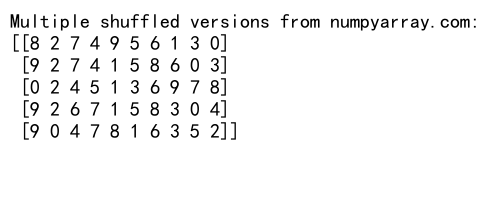
This approach is more efficient than using a loop to generate multiple shuffled versions of the array.
Future Developments and Trends
As the field of scientific computing and data science continues to evolve, we can expect further developments in random number generation and shuffling algorithms. Some potential areas of improvement include:
- Enhanced support for parallel and distributed random number generation.
- More sophisticated shuffling algorithms for specific use cases, such as weighted shuffling or constrained shuffling.
- Integration of true random number generators (TRNGs) for applications requiring non-deterministic randomness.
- Improved performance and memory efficiency for shuffling and random number generation with very large datasets.
NumPy shuffle and random state Conclusion
NumPy shuffle and random state are fundamental concepts in scientific computing and data analysis. They provide the foundation for reproducible experiments, data augmentation, and various statistical techniques. By understanding how to effectively use these tools, you can ensure the reliability and reproducibility of your data science workflows.
Throughout this article, we’ve explored the basics of NumPy shuffle and random state, delved into advanced techniques, and examined their applications in various domains. We’ve seen how these concepts are crucial in machine learning, statistical analysis, and Monte Carlo simulations.
Remember to always set a random seed when reproducibility is important, and be mindful of how random state behaves in different contexts, especially in parallel computing environments. By following best practices and understanding the nuances of NumPy shuffle and random state, you’ll be well-equipped to handle a wide range of data manipulation and analysis tasks.